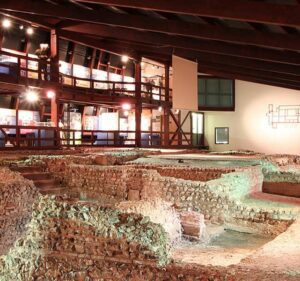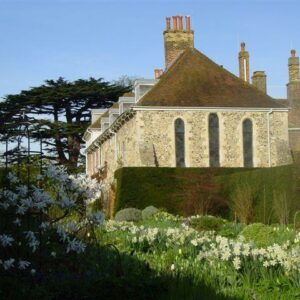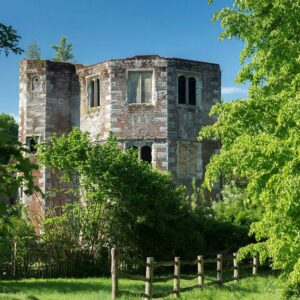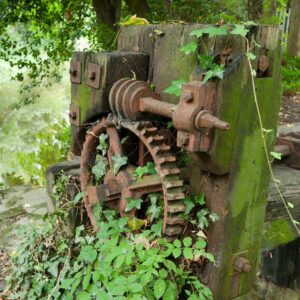Discovering the rich archaeological heritage of the Darent Valley

28th May 2025
Located just 15 km from the hustle and bustle of London, the Darent Valley is celebrated for its stunning natural beauty and its deep historical significance. Over the past seven years, the valley’s archaeological heritage has been brought into the spotlight through the work of the Darent Valley Landscape Partnership Scheme (DVLPS), supported by funding from the National Lottery Heritage Fund and DEFRA. Through these efforts, the past has been unearthed, allowing us to learn more about the lives of those who shaped the valley over thousands of years.
From prehistoric tools to medieval monastic remains, the Darent Valley holds countless clues to the region’s past.
A walk through time: prehistoric to Roman discoveries
The Darent Valley has always been a significant area for human settlement. Evidence of prehistoric life in the valley includes stone tools and animal remains found along the riverbanks, offering us a glimpse into the lives of the earliest human inhabitants. As we move forward in time, one of the most remarkable discoveries is the Lullingstone Roman Villa, an extraordinary site that provides a detailed look into Roman Britain. Lullingstone Roman Villa is one of the best-preserved Roman villas in the UK, offering rare insights into the daily life of the Roman elite. Excavations carried out between 2019 and 2021, as part of the DVLPS, saw more than 130 adults and 185 children take part in digging, uncovering fascinating artefacts, and further revealing the villa’s complex history. Among the discoveries was a previously unknown Early Roman or Late Iron Age enclosure ditch and a Roman ritual pit, which adds another layer to our understanding of Roman life in the valley.


The granary was also re-dated to the 5th century, suggesting the villa continued to be used in the post-Roman period, well beyond the traditional fall of the Roman Empire in Britain. Likewise, Mesolithic evidence was found, marking the earliest known occupation of the site. These findings are crucial for understanding the villa’s history but how Roman Britain adapted to changing times.
In collaboration with English Heritage, a new interactive online map was developed, offering people a digital experience of the Roman Darent Valley. This map allows visitors to explore the villa’s layout and artefacts from the comfort of their own homes, making the ancient history of the valley more accessible to the public.
Medieval mysteries at St. John’s Jerusalem and Lullingstone Castle
Moving into the medieval period, the Darent Valley was home to a preceptory of the Knights Hospitaller, a religious military order known for their involvement in the Crusades, at St John’s Jerusalem, located in Sutton-at-Hone.
In 2023, a community archaeology dig at St John’s Jerusalem uncovered evidence of its 12th-century Norman origins, confirming the site’s earlier historical importance than previously understood. More than 50 volunteers, including from the Bexley Young Archaeologists Club and local scout groups, took part in the excavation, which revealed evidence of extensive activity from the 12th through the 16th centuries.


The findings are significant, as they offer new insights into the Knights Hospitaller’s activities in rural Britain and offer a rare window into medieval life.
Another community archaeology project was centred on the historic gardens of Lullingstone Castle, where geophysical survey and excavation by a large volunteer team in 2022 investigated the medieval origins of the house and the inner moat which was filled in in the late 18th century. Environmental evidence also showed what people of the house ate in the medieval and Georgian period, as well as some of the plants which were growing in the gardens at that time.
Tudor heritage: The Otford Archbishop’s Palace
Not all the Darent Valley’s history is Roman or medieval. The Otford Archbishop’s Palace is a key monument to Tudor England and is a critical part of the valley’s heritage. In recent years, the Archbishop’s Palace Conservation Trust has worked with the DVLPS to carry out extensive conservation work at the site. This included stabilising the north-west tower and installing a new weather-tight roof, with the aim of eventually transforming the palace into a heritage centre for the local community.


In 2021, a volunteer-led high-resolution geophysical survey of the site uncovered previously unknown features of the palace, including a polygonal corner tower and a masonry aisled hall, now known through a small excavation to be 13th or 14th century in date. These findings provide further evidence of the site’s significance and add depth to our understanding of the region’s medieval and Tudor history.
Preserving industrial heritage
The Dartford Gunpowder Mills, along the River Darent, were once among the largest producers of gunpowder in Britain. Though the site has been neglected and vandalised in recent years, DVLPS has worked to preserve and interpret the remaining industrial features.


The project included the removal of graffiti, stabilising the wall foundations, and installing new interpretation boards to educate the public about the mills’ historical significance. This site represents a crucial part of the valley’s industrial history and provides a fascinating contrast to its earlier archaeological heritage.
Getting the community involved
One of the most remarkable aspects of the DVLPS project is its commitment to community involvement. Over the past several years, more than 4,000 residents, schoolchildren, and volunteers had the opportunity to take part in the archaeological process. Whether through excavations, workshops, or field surveys, they have connected with their history in a way textbooks simply can’t provide.
The Tea Barn team at Castle Farm in Shoreham exemplifies this spirit of community archaeology. Volunteers at the Tea Barn help process and archive archaeological finds from ongoing excavations, including Roman pottery from the Discovering Roman Otford Project. This volunteer-led initiative ensures the valley’s rich archaeological history is documented and preserved for future generations.
The ongoing journey
While the DVLPS project is coming to an end, the archaeological journey in the Darent Valley is far from over. New discoveries are still being made, and the ongoing work of our community archaeologists and local volunteers ensures the valley’s past will continue to reveal itself. The stories of the Romans, the Knights Hospitaller, and the valley’s early inhabitants are still being pieced together, and the knowledge uncovered will continue to shape our understanding of this remarkable region.
Popular articles
The Best Viewpoints in the Kent Downs
Searching for incredible views? Look no further! We've rounded up the best…
Top 5 bluebell walks in the Kent Downs
If you're looking for inspiration on the best places for some bluebell…
Lambing season in the Kent Downs
Discover the importance of lambing season in the Kent Downs and find…
